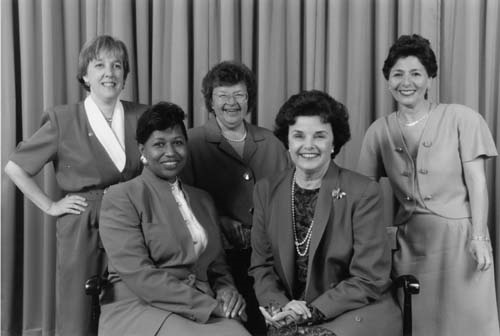Senator Barbara Mikulski standing with women senatorial candidates
Laura Patterson, [Senator Barbara Mikulski standing with women senatorial candidates (left to right) Carol Moseley-Braun, Barbara Boxer, Senator Patty Murray and others at 1992 Democratic National Convention, Madison Square Garden, New York City], July 2022. Library of Congress Prints and Photographs Division.
Background
The treatment of Anita Hill during the Senate confirmation hearings for Supreme Court Justice Clarence Thomas in 1991 was a sign to many women that they did not have adequate representation in Congress. At the time of the hearings, only two of the 100 senators were women: Republican Nancy Kassebaum of Kansas and Democrat Barbara Mikulski of Maryland. Neither sat on the Judiciary Committee, which oversaw the confirmation process. In a protest to demand justice, seven female members of the House, all Democrats, marched to the Senate. The Senate agreed to delay the vote, but confirmed Thomas a week later in a 52-48 vote.
Fueled, in part, by the confirmation, several female politicians decided to run for Senate in the 1992 elections. When four of them won their races, the media coined 1992 the “Year of the Woman.” Barbara Boxer and Dianne Feinstein both won their elections to represent California, making it the first state in history to be represented by two female senators. Carol Mosely Braun was victorious in her Illinois race and became the first Black woman in the Senate. Patty Murray won her election to represent the state of Washington. In addition to the four new female Senators, Mikulski won re-election as well (Kassebaum was not up for election in 1992).
The Capitol Building and the protocol of the Senate were not designed with women in mind. For example, there were no women’s restrooms near the Senate Chamber until 1992. The following year, Senators Barbara Mikulski and Carol Mosely Braun wore pants on the Senate floor, which was against the rules of the Senate, which has strict dress codes for all senators. In response, the rule changed but women would only be allowed to wear pants if they wore a jacket.
As of 2022, there are 24 active female senators.
About the Document
The first photograph shows Senator Barbara Mikulski and female candidates for the U.S. Senate at the 1992 Democratic National Convention at Madison Square Garden in New York City.
The second photograph depicts the five female Democratic Senators in 1993. From left to right: Patty Murray (WA), Carol Mosely Braun (IL), Barbara Mikulski (MD), Dianne Feinstein (CA), and Barbara Boxer (CA). Patty Murray and Dianne Feinstein are still active senators today.
The suit belonged to Carol Mosely Braun, the first Black female Senator. She served one term representing the state of Illinois. Kamala Harris is the only other Black woman to have been a Senator. She represented California until she became vice president in 2021.
Vocabulary
- Democratic National Convention: The event during which the Democratic Party chooses its candidate for president. It is also an opportunity for caucuses and other groups to meet and decide on party activities.
- Judiciary Committee: Committee of Senators that oversees the Department of Justice. One of their responsibilities is to conduct hearings for nominated judges and justices.
Discussion Questions
- Why was 1992 called the “Year of the Woman”? What inspired the female candidates to run for office in the Senate specifically?
- What challenges did female Senators face because of their gender? What do their experiences say about the way the Senate was run since the eighteenth century?
- Why is it important for women to be represented in the Senate? What effects do you think having more female Senators had on legislation?
- Today there are 24 female Senators and 127 female members of the House of Representatives. Why was it a major achievement to have five women in the Senate in 1992? What do you think has changed in American politics since 1992?
Suggested Activities
- AP Government Connections:
- 5.9: Congressional Elections
- 5.10: Modern Campaigns
- Include this resource in a discussion about women’s rights today. How can this resource help students understand why women’s issues are often not prioritized by Congress today?
- Pair this resource with Anita Hill’s testimony to consider the impact her testimony had on American politics.
- Female Senators had to establish new norms for the clothing they wore on the Senate floor. Analyze the suit worn by Carol Mosely Braun alongside images of power suits. How did women balance their gender expression with professional dress norms in traditionally male workplaces?
- Consider the role of women in politics during this period by combining this resource with a testimony about music censorship, Geraldine Ferraro’s acceptance speech, Anita Hill’s testimony, Maxine Waters on the Rodney King verdict, Hillary Clinton’s speech, and the life stories of Sandra Day O’Connor and Barbara Lee.
Themes
POWER AND POLITICS









